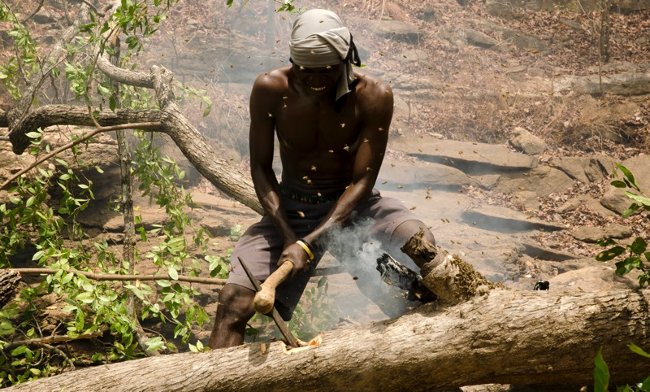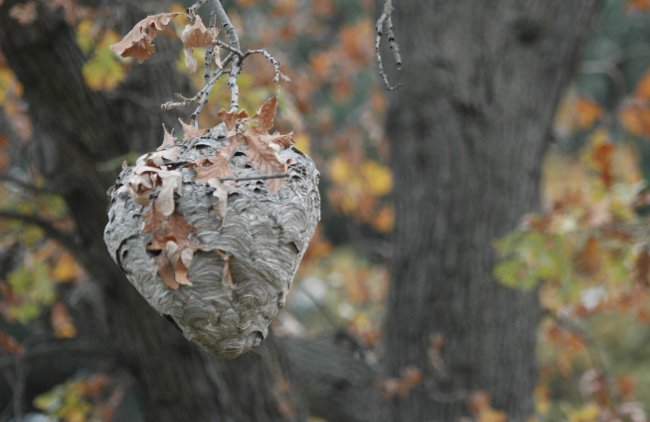The mystery of how people and birds communicate
Honey pickers often find and break into beehives together.
 Honey Helper is a honey hunter in Mozambique, Africa.He always carried with him a small bird parked in his hand to lead the way to the hives.
Honey Helper is a honey hunter in Mozambique, Africa.He always carried with him a small bird parked in his hand to lead the way to the hives.
A new study shows that these birds are often the guide for workers to go to the hives after hearing "command signal" before each trip. When asked for directions, the bird who understands this language will guide African honey hunters to the place to get the honey. All of them sound very loudly with strong vibrations of " brrr-hm " emitted.
Ecologist Claire Spottiswoode and her colleague at Camridge University said that there is a bird known as a guide ( guide ) to hunters to get Mozambique honey to beehives after listening to the signaling signal. In the Science discussion held on July 22, the scientists named the birds that support people in finding hard-to-reach foods.
Recent research provides the first evidence of communication between humans and wildlife. In some parts of the world, dolphins often help fishermen fly fish into the net, but there is still no clear indication of special messages between fishermen and dolphins.
Spottiswoode said that these birds coordinate with hunters to distinguish between hunting signs and food search. These birds often respond to this announcement with a loud vibrato to warn people about their presence. After that, they fly from tree to tree until the honeycomb.
Spottiswoode said " The bees in the nest can burn a bird to death " but the birds that eat beeswax still regularly fly into that dangerous honeycomb area and bring the beeswax out.

The hunter named Yao chopped trees to preserve the intact honeycomb lying on the high slits and sucked them all out by burning tree branches and leaves. After taking the bees out of the nest, Yao removed the beeswax for his powerful assistant, and even put beeswax on the leaves to let the bird slowly enjoy.
In the previous text, it was reported that 1588 beehives were led by these birds.Harvard University biologist Richard Wrangham said that axes are like other stone tools and how to create fire was invented about 1 million years ago or more. Therefore, it is possible that humans and birds have hunted together for at least such a long time.
Spottiswoode said that other parts of South Africa also often responded to the local honey gathering group. Yale University biologist Brian Wood runs a team that proves that the person who took the Hadza honey in Tanzania whistled to call the guide birds, and the walkers also said or shouted to call those birds.
Unlike Yao, the Hadza often buried or burned many beeswax in their nests. Hadza honey hunters often let hungry birds and urged them to lead them to find other groups. Wood's team estimates that 8 to 10 percent of Hadza food is found by birds.
Wood talks about new research " documents about traditional culture of people and birds ".

Spotiswoode's team conducted fieldwork in October 2013 and September, October 2015. Researchers tracked the movement of six birds that were signaled. Overall, 73 out of 97 birds found honey to find at least one honeycomb. During the course of the study, about 112 beehives were found by the Yao with the help of birds.
In another experiment, Spottiswoode asked two Yao honey hunters to find 72 beehives, each took about 15 minutes. During a search, a person holding the recorder for about 7 seconds turned it on once or someone made a "brrr-hm" sound, and one would call them " guide birds " or proper names. Use pigeons' necklace or excitement calls.
The birds participated in the 30 research experiments, about two-thirds used " brrr-hm " to call for the help of those birds (although they often did not identify the bird's nest location). A quarter uses a tape recorder and a third uses pigeon sounds to announce help from birds.
Spottiswoode's team is estimated that honey pickers use three times more " brrr-hm " sound than people who use Yao language or pigeon sounds to be found within 15 minutes. .
Spottiswoode and Wood plan to investigate small birds learning how to identify workers' messages looking for honey from mature birds so they can lead them to places with honeycomb.
You should read it
- What happens if you mix honey with cinnamon powder every day?
- How to heal wounds quickly and effectively with honey
- What is the effect of honey pickled garlic? How to soak garlic with honey
- How to soak and preserve ginseng with standard honey at home
- Beat the hateful colds with honey
- The number of honey bees in the world decreased by nearly 12%
- Why is December called honey month?
- The effects of cordyceps honey soaked? How to soak?
May be interested
- Turn a dead bird into a drone to improve snooping
 researchers have launched a project to incorporate dead birds into drones to help improve future ways of snooping and tracking wildlife.
researchers have launched a project to incorporate dead birds into drones to help improve future ways of snooping and tracking wildlife. - The ultimate snake surgery of the tall bird is called the 'Taekwondo killer'.
 a close-up of snake-eating kite birds uses their toenails to attack successively on their prey and re-eat the snake in just 1 minute.
a close-up of snake-eating kite birds uses their toenails to attack successively on their prey and re-eat the snake in just 1 minute. - How to Communicate Well With People from Other Cultures
 to build good relationships with people from other cultures, it is essential to learn how to communicate with them verbally and non-verbally. you can make things easier by also learning about their culture and practicing tolerance. armed...
to build good relationships with people from other cultures, it is essential to learn how to communicate with them verbally and non-verbally. you can make things easier by also learning about their culture and practicing tolerance. armed... - All Angry Birds games are free on Windows Phone Store
 the fact that all free angry birds games on windows phone store are considered a big black friday that rovio is for those who are using windows phone.
the fact that all free angry birds games on windows phone store are considered a big black friday that rovio is for those who are using windows phone. - The 2000-year mystery has yet to be solved for the giant drawings on the Nazca Plateau
 appearing from 2000 years ago, the strange lines called nazca lines (nazca lines) are considered one of the most mysterious and confusing mysteries in human history.
appearing from 2000 years ago, the strange lines called nazca lines (nazca lines) are considered one of the most mysterious and confusing mysteries in human history. - Capybara: A giant rat weighing up to 68kg, at ease among crocodiles thanks to its special abilities
 capybaras not only have a cute appearance, but they are also considered the friendliness queens in the animal world as they love to 'communicate' with many other species from birds, cats, monkeys to predators. meat like crocodile.
capybaras not only have a cute appearance, but they are also considered the friendliness queens in the animal world as they love to 'communicate' with many other species from birds, cats, monkeys to predators. meat like crocodile. - The mystery of no solution, 16 feet of people drifting to the coast for 10 years scared many people
 since 2007, there have been about 16 human legs still in shoes on the coast of british columbia, canada. so far, no one knows who those legs are, from where to make this frightening event become the unexplained mystery of the 21st century.
since 2007, there have been about 16 human legs still in shoes on the coast of british columbia, canada. so far, no one knows who those legs are, from where to make this frightening event become the unexplained mystery of the 21st century. - Found fossils of prehistoric 127 million year old small birds
 a scientist has discovered a small prehistoric fossil dating from the mesozoic era (250-65 million years ago) that helped them better understand the first small birds that appeared in the dinosaur era. .
a scientist has discovered a small prehistoric fossil dating from the mesozoic era (250-65 million years ago) that helped them better understand the first small birds that appeared in the dinosaur era. . - Birds flying in the sky also have days of death by a group of crabs
 just because of a small accident, the poor bird became a good meal for the hungry crabs. perhaps this is the only time in the lives of the crabs enjoying the flesh of a flying creature in the sky that normally doesn't think they dare to think about!
just because of a small accident, the poor bird became a good meal for the hungry crabs. perhaps this is the only time in the lives of the crabs enjoying the flesh of a flying creature in the sky that normally doesn't think they dare to think about! - 10 smartest talking birds in the world
 what are talking parrots? talking parrots are just one of the many talking birds in the world. let's learn about them together!
what are talking parrots? talking parrots are just one of the many talking birds in the world. let's learn about them together!










 Amazing records of the weather in human history
Amazing records of the weather in human history Explore the world's deepest green hole in the South China Sea
Explore the world's deepest green hole in the South China Sea Surprise with the facts about the ocean
Surprise with the facts about the ocean Will disaster happen when the leaves in Chernobyl area do not decompose?
Will disaster happen when the leaves in Chernobyl area do not decompose? Hate to make a strange snake lizard-like creature
Hate to make a strange snake lizard-like creature What ancient monsters can kill Megalodon super shark?
What ancient monsters can kill Megalodon super shark?